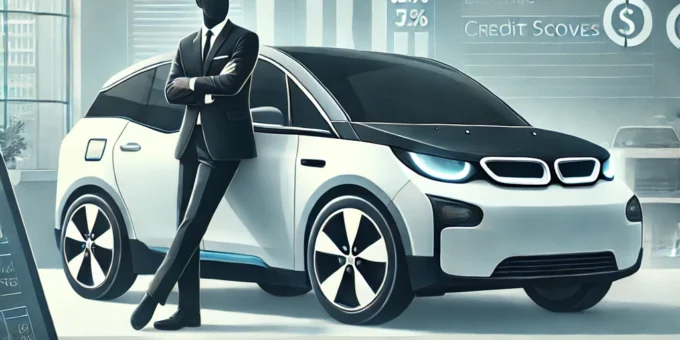
Electric vehicles (EVs) are an exciting and eco-friendly way to embrace the future of transportation. However, their higher upfront cost can be a concern for buyers. Securing low-interest EV financing is one of the smartest ways to make EV ownership more affordable. With the right strategies, you can reduce your overall loan costs and enjoy the benefits of clean, efficient driving.
In this guide, we’ll explore how to qualify for low-interest EV financing by improving your credit score, leveraging green loan programs, and taking advantage of government incentives.
Introduction
Low-interest financing is a game-changer when buying an EV. A lower interest rate can save you thousands of dollars over the life of your loan, making it easier to fit the vehicle into your budget. While not everyone qualifies for the lowest rates, taking steps to improve your financial profile can significantly boost your chances.
This guide will walk you through the qualifications and practical tips to secure the best possible financing for your electric vehicle.
Why Low-Interest EV Financing Matters
- Lower Total Costs: Save money over the loan term with reduced interest payments.
- Affordable Monthly Payments: Keep payments manageable by securing competitive rates.
- Enhanced Buying Power: Access better EV models within your budget.
- Environmental Benefits: Make the transition to sustainable transportation easier and cost-effective.
How to Qualify for Low-Interest EV Financing
1. Build and Maintain a Good Credit Score
Your credit score is the single most important factor in determining your interest rate. Lenders reward borrowers with good or excellent credit by offering lower rates.
Steps to Improve Your Credit:
- Pay bills on time to establish a positive payment history.
- Reduce credit card balances to lower your credit utilization ratio.
- Avoid opening new lines of credit before applying for a loan.
- Check your credit report for errors and dispute inaccuracies.
Pro Tip: Aim for a credit score of 700 or higher to qualify for the best rates.
2. Save for a Larger Down Payment
The more money you put down upfront, the smaller your loan amount will be, reducing the lender’s risk and qualifying you for better rates.
Benefits of a Larger Down Payment:
- Lowers your loan-to-value (LTV) ratio, making you a more attractive borrower.
- Reduces your monthly payments and total interest paid.
Pro Tip: Aim for at least 20% of the vehicle’s purchase price as a down payment.
3. Choose the Right Lender
Not all lenders offer the same rates, especially for EV financing. Shop around to find lenders with the best terms for eco-friendly purchases.
Types of Lenders to Consider:
- Green Loan Programs: Many banks and credit unions offer green loans specifically for EVs, often at lower rates.
- Manufacturer Financing: Automakers like Tesla, Hyundai, and Nissan provide competitive in-house financing.
- Credit Unions: Known for offering lower rates and personalized service.
- Online Lenders: Convenient and often quick to approve applications.
Pro Tip: Compare offers from at least three lenders before making a decision.
4. Leverage EV Incentives and Rebates
Government incentives can significantly reduce the cost of your EV purchase, indirectly improving your financing options.
Common Incentives:
- Federal Tax Credit: Up to $7,500 for eligible EVs in the U.S.
- State Rebates: Additional rebates, sales tax exemptions, or grants in certain states.
- Utility Discounts: Rebates from energy providers for purchasing EVs or installing charging stations.
Pro Tip: Use these incentives to make a larger down payment or reduce the total loan amount.
5. Opt for a Shorter Loan Term
Shorter loan terms typically come with lower interest rates. While monthly payments may be higher, the total interest paid over the loan’s life is significantly less.
Common Loan Terms:
- 36 months: Lowest rates but highest monthly payments.
- 48 months: Balanced option for most borrowers.
- 60 months or more: Higher rates but lower monthly payments.
Pro Tip: Choose the shortest loan term you can comfortably afford.
6. Get Pre-Approved for a Loan
Pre-approval simplifies the car-buying process by letting you know what rates and terms you qualify for before shopping.
Benefits of Pre-Approval:
- Helps you set a realistic budget.
- Shows dealerships you’re a serious buyer.
- Gives you leverage to negotiate better terms.
Pro Tip: Pre-approval does a soft credit check, so it won’t affect your credit score.
7. Negotiate the Car Price
The lower the car’s purchase price, the less you’ll need to finance, which can lead to better rates.
How to Negotiate Effectively:
- Research market prices for the EV model you want.
- Look for discounts, promotions, or seasonal deals.
- Use multiple quotes from dealerships to your advantage.
Pro Tip: Finalize the car price before discussing financing options.
8. Avoid Loan Pitfalls
To secure the best rates, steer clear of common mistakes:
- Skipping Comparisons: Failing to shop around for the best rates can cost you thousands in interest.
- Overextending Your Budget: Borrowing more than you can afford leads to financial stress.
- Ignoring Fine Print: Check for hidden fees, prepayment penalties, or variable rates.
Top Lenders for Low-Interest EV Financing
1. LightStream Green Loans
- Offers competitive rates for EV buyers with good credit.
- No restrictions on EV brands or models.
2. Tesla Financing
- Exclusive for Tesla buyers with flexible terms and competitive rates.
3. Alliant Credit Union
- Known for its green auto loan program with low-interest rates.
4. Bank of America Auto Loans
- Nationwide lender with fast approvals and competitive rates.
5. Online Platforms
- LendingTree and NerdWallet help you compare multiple lenders at once.